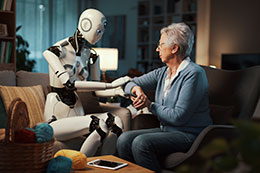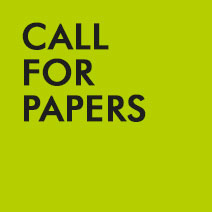Inteligencia artificial emocional en el reverso del test de Turing. Al borde de la singularidad tecnológica son precisas cuatro nuevas leyes para la robótica
DOI:
https://doi.org/10.14422/rib.i25.y2024.003Palabras clave:
ética de la inteligencia artificial, IA emocional, test de Turing, inteligencia fuerte, inteligencia generalResumen
En este artículo defiendo que el creciente desarrollo de la inteligencia artificial específica (IAE) y, en particular, de la IAE para la interacción emocional (IAE-E), puede ir desdibujando las fronteras existentes entre los problemas éticos asociados a la IA débil (IAD), pequeños y presentes, ahora o a corto plazo, y los asociados a la IA fuerte (IAF), de gran calado y solo teóricos o potencialmente presentes a largo plazo. En mi argumentación muestro la importancia que adquiere el test de Turing, por su aproximación objetivo-subjetiva, al análisis y evaluación del segundo tipo de riesgos. Porque no se trata únicamente de cuánto la IAE-E es capaz de simular la inteligencia humana, sino también de cuánto más susceptibles somos los seres humanos de ser persuadidos por dichas simulaciones. La conclusión principal a la que llego es que para que el desarrollo tecnológico depare en progreso humano, necesitamos ser conscientes de los efectos que tiene para la IA-E, primero, el paroxismo social en las estrategias de autoengaño, segundo, la barbarie del especialismo y, tercero, el primitivismo tecnológico y docente.
Descargas
Referencias
Alkaissi, H., & McFarlane, S. I. (2023). Artificial Hallucinations in ChatGPT: Implications in Scientific Writing. Cureus, 15(2), e35179. https://doi.org/10.7759/cureus.35179
Asimov, I. (1950). Runaround. En I, Robot (The Isaac Asimov Collection ed.). Doubleday.
Bergson, H. (2007). La evolución creadora. Cactus.
Bermúdez, J. L. (2003). Thinking without Words. Oxford University Press. https://doi.org/10.1093/acprof:oso/9780195159691.001.0001
Bostrom, N. (2016). Superinteligencia: Caminos, peligros, estrategias. Editorial TEELL.
Chalmers, D. (1996). The Conscious Mind: In Search of a Fundamental Theory. Oxford University Press.
Consejo Europeo. (2024). Reglamento de Inteligencia Artificial. Publicado en la Web del Consejo de la Unión Europea el 9 de diciembre de 2023. Consultado el 12 de febrero de 2024. https://www.consilium.europa.eu/es/press/press-releases/2023/12/09/artificial-intelligence-act-council-and-parliament-strike-a-deal-on-the-first-worldwide-rules-for-ai/
CORDIS. (2024). Culture Aware Robots and Environmental Sensor Systems for Elderly Support. Publicado en EU Research Results. European Commission. https://cordis.europa.eu/project/id/737858
Crawford, K. (2021). Atlas of AI: Power, Politics, and the Planetary Costs of Artificial Intelligence. Yale University Press. https://doi.org/10.12987/9780300252392
Damasio, A. R. (1994). Descartes’ Error: Emotion, Reason and the Human Brain. GP Putnam’s Sons.
Davidson, D. (2002). Subjective, Intersubjective, Objective. Oxford University Press. https://doi.org/10.1093/0198237537.001.0001
Dennet, D. C. (2018). From Bacteria to Bach and Back: The Evolution of Minds. Penguin Random House.
Eccles, J. (2015). How the Self Controls Its Brain. Springer Verlag.
Echarte, L. E. (2019). Self-Lie Detection: New Challenges for Moral Neuroenhancement. En P. Gargiulo & H. L. Mesones-Arroyo (eds.), Psychiatry and Neuroscience Update (vol. III, pp. 43-52). Springer. https://doi.org/10.1007/978-3-319-95360-1_4
Echarte, L. E. (2023a). El retorno de los oráculos. Inteligencia Artificial y la transformación del paradigma médico. En R. Amo Usanos (ed.), Inteligencia Artificial y Bioética (pp. 97-116). Universidad Pontificia Comillas.
Echarte, L. E. (2023b). Exploring moral perception and mind uploading in Kazuo Ishiguro’s ‘Klara and the Sun’: ethical-aesthetic perspectives on identity attribution in artificial intelligence. Frontiers in Communication, 8, 1272556. https://doi.org/10.3389/fcomm.2023.1272556
Fodor, J. (2000). The Mind Doesn’t Work That Way: The Scope and Limits of Computational Psychology. The MIT Press. https://doi.org/10.7551/mitpress/4627.001.0001
Gayozzo, P. A. (2021). Singularidad tecnológica y transhumanismo. Teknokultura. Revista de Cultura Digital y Movimientos Sociales, 18(2), 195-200. https://doi.org/10.5209/tekn.74056
Good, I. J. (1965). Speculations Concerning the First Ultraintelligent Machine. Advances in Computers, 6, 31-38. https://doi.org/10.1016/S0065-2458(08)60418-0
Gubern, R. (2000). El eros electrónico. Taurus.
Hameroff, S. R., Kaszniak, A. W., & Scott, A. C. (1996). Toward a Science of Consciousness. The First Tucson Discussions and Debates. The MIT Press. https://doi.org/10.7551/mitpress/6860.001.0001
Heidegger, M. (1962). Being and Time. Blackwell.
James, F., & Moneta, L. (2020). Review of High-Quality Random Number Generators. Computing and Software for Big Science, 4(2). https://doi.org/10.1007/s41781-019-0034-3
Jeeves, M., & Brown, W. S. (2009). Neuroscience, Psychology, and Religion: Illusions, Delusions, and Realities About Human Nature. University of Chicago Press.
Jeste, D. V., Lee, E. E., & Cacioppo, S. (2020). Battling the Modern Behavioral Epidemic of Loneliness: Suggestions for Research and Interventions. JAMA Psychiatry, 77(6), 553-554. https://doi.org/10.1001/jamapsychiatry.2020.0027
Kauffman, S. A., & Roli, A. (2023). What is consciousness? Artificial intelligence, real intelligence, quantum mind and qualia. Biological Journal of the Linnean Society, 139(4), 530-538. https://doi.org/10.1093/biolinnean/blac092
Lipovetsky, G. (2000). La era del vacío. Ensayos sobre el individualismo contemporáneo. Anagrama.
Moore, J. (2003). Explanation and Description in Traditional Neobehaviorism, Cognitive Psychology, and Behavior Analysis. En K. A. Lattal & P. N. Chase (eds.), Behavior Theory and Philosophy (pp. 13-39). Springer. https://doi.org/10.1007/978-1-4757-4590-0_2
OESD. (2024). Estudio sobre juventud y soledad no deseada en España. Observatorio Estatal de la soledad no deseada. https://www.soledades.es/estudios/estudio-sobre-juventud-y-soledad-no-deseada-en-espana
OESD. (2024). Informe de Percepción Social de la soledad no deseada. Observatorio Estatal de la soledad no deseada. https://www.soledades.es/estudios/informe-de-percepcion-social-de-la-soledad-no-deseada
Office of the Surgeon General (OSG). (2023). Our Epidemic of Loneliness and Isolation: The U.S. Surgeon General’s Advisory on the Healing Effects of Social Connection and Community. US Department of Health and Human Services. https://www.hhs.gov/sites/default/files/surgeon-general-social-connection-advisory.pdf
Ortega y Gasset, J. (2008). La rebelión de las masas. Tecnos.
Penrose, R. (1994). Shadows of the Mind. Oxford University Press.
Platón. (1997). Apología de Sócrates. Editorial Universitaria.
Putnam, H. (1975). Mind, Language and Reality. Philosophical Papers (vol. 2). Cambridge University Press. https://doi.org/10.1017/CBO9780511625251
Riesman, D., Glazer, N., & Denney, R. (2020). The Lonely Crowd: A Study of the Changing American Character. Yale University Press. https://doi.org/10.12987/9780300253474
Ryle, G. (1978). The Concept of Mind. Penguin.
Searle, J. R. (2007). Biological Naturalism. En M. Velmans & S. Schneider (eds.), The Blackwell Companion to Consciousness (pp. 325-334). Blackwell Publishing. https://doi.org/10.1002/9780470751466.ch26
Searle, J. R. (1994). The Rediscovery of the Mind. MIT Press.
Searle, J. R. (1983). Intentionality: An Essay in the Philosophy of Mind. Cambridge University Press. https://doi.org/10.1017/CBO9781139173452
Searle, J. R. (1980). Minds, brains, and programs. Behavioral and Brain Sciences, 3(3), 417-457. https://doi.org/10.1017/S0140525X00005756
Smart, J. C. (2004). Consciousness and Awareness. Journal of Consciousness Studies, 11, 41-50.
Taylor, C. (2001). Sources of the Self: The Making of the Modern Identity. Harvard University Press.
Turing, A. M. (1950). Computing machinery and intelligence. Mind, LIX(236), 433-460. https://doi.org/10.1093/mind/LIX.236.433
Wittgenstein, L. (1973). Tractatus Logico-Philosophicus. Alianza.

Descargas
Publicado
Número
Sección
Licencia
Derechos de autor 2024 Luis Enrique Echarte Alonso
Los autores de artículos aceptados en la Revista Iberoamericana de Bioética conservan los derechos de propiedad intelectual sobre sus trabajos y otorgan a la revista los permisos de distribución y comunicación pública de los mismos, consintiendo que se publiquen bajo una licencia Creative Commons Atribución-NoComercial-SinDerivadas 4.0 Internacional. Se recomienda a los autores publicar su trabajo en Internet (por ejemplo en páginas institucionales o personales, repositorios, etc.) respetando las condiciones de esta licencia y citando debidamente la fuente original.
















